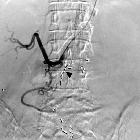acute cholecystitis


























Acute cholecystitis refers to the acute inflammation of the gallbladder. It is the primary complication of cholelithiasis and the most common cause of acute pain in the right upper quadrant (RUQ).
Epidemiology
Acute cholecystitis is a common cause of hospital admission and is responsible for approximately 3-10% of all patients with abdominal pain. Cholelithiasis is the major risk factor and causes up to 95% of cases.Other risk factors include AIDS, fibrate use, and ascariasis.
Clinical presentation
Constant right upper quadrant pain that can radiate to the right shoulder. Pain typically persists for more than six hours, in contradistinction to the intermittent right upper quadrant pain of biliary colic. Nausea, vomiting, and fever are also often reported.
Pathology
90-95% of cases are due to gallstones (i.e. acute calculous cholecystitis) with the remainder being acute acalculous cholecystitis.
The development of acute calculous cholecystitis follows a sequence of events:
Radiographic features
Ultrasound (US) is the preferred initial modality in the investigation of right upper quadrant pain. It is more sensitive than HIDA scintigraphy and CT in the diagnosis of acute cholecystitis, and more readily available.
Ultrasound
The most sensitive US finding in acute cholecystitis is the presence of cholelithiasis in combination with the sonographic Murphy sign. Both gallbladder wall thickening (>3 mm) and pericholecystic fluid are secondary findings.
Other less specific findings include gallbladder distension and sludge.
Every effort should be made to demonstrate the obstructing stone in the gallbladder neck or cystic duct.
Nuclear medicine
Tc-HIDA scintigraphy
HIDA cholescintigraphy in acute cholecystitis will demonstrate non-visualization of the gallbladder.
Cholescintigraphy is unable to demonstrate many complications of cholecystitis, nor the alternative diagnoses which may be found with ultrasound. It is therefore reserved for the evaluation of sonographically equivocal cases.
CT
Although traditionally considered less sensitive than ultrasound, some reviews find CT more sensitive for this diagnosis . An advantage is that CT also allows better evaluation of other pathologies at the same time. CT findings include :
- cholelithiasis: gallstones isodense to bile will be missed on CT
- gallbladder distension
- gallbladder wall thickening
- mural or mucosal hyperenhancement
- pericholecystic fluid and inflammatory fat stranding
- enhancement of the adjacent liver parenchyma due to reactive hyperemia
- tensile gallbladder fundus sign
- fundus bulging the anterior abdominal wall
- ~75% sensitivity and ~95% specificity for acute cholecystitis in the absence of any other CT features
- useful sign in making an early diagnosis
Diagnostic criteria on CT as proposed by Mirvis et al. include :
- major criteria
- gallstones
- thickened gallbladder wall
- pericholecystic fluid collections
- subserosal edema
- minor criteria
- gallbladder distention
- sludge
- diagnosis of acute cholecystitis can be supported if one major and two minor criteria are present
MRI
MRI is sensitive in the detection of acute cholecystitis, with findings similar to those seen on ultrasound and CT . MR cholangiopancreatography (MRCP) may show an impacted stone in the gallbladder neck or cystic duct as a rounded filling defect.
Treatment and prognosis
Urgent surgical removal of the gallbladder is the treatment of choice for the uncomplicated disease. Gallbladder ischemia with transmural necrosis may occur if the obstruction persists.
Complications
- gangrenous cholecystitis (most common - 20%)
- gallbladder perforation (~5%)
- emphysematous cholecystitis
- pericholecystic abscess
- cholecystoenteric fistula
- cholecystocutaneous fistula
- vascular complications (gallbladder hemorrhage, portal vein thrombosis, cystic artery pseudoaneurysm)
Differential diagnosis
The differential diagnosis for acute cholecystitis is extensive and includes:
- choledocholithiasis
- pancreatitis
- peptic ulcer disease
- acute hepatitis
- liver abscess
- sub-hepatic appendicitis
For a more extensive differential, please refer to the article on the differential diagnosis of diffuse gallbladder wall thickening.
See also
- cholecystitis
- chronic cholecystitis
- acute acalculous cholecystitis
- Mirizzi syndrome
- xanthogranulomatous cholecystitis
Siehe auch:
- Pankreatitis
- Leberabszess
- Choledocholithiasis
- Magenulkus
- Cholezystitis
- xanthogranulomatöse Cholezystitis
- Mirizzi-Syndrom
- differential diagnosis of diffuse gallbladder wall thickening
und weiter:

 Assoziationen und Differentialdiagnosen zu akute Cholezystitis:
Assoziationen und Differentialdiagnosen zu akute Cholezystitis:





